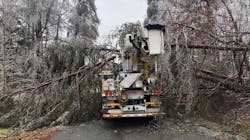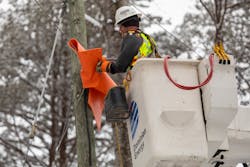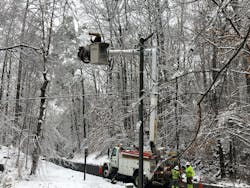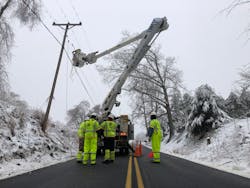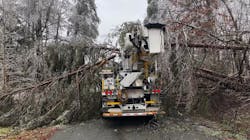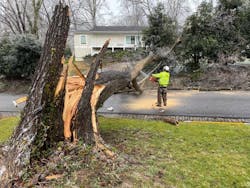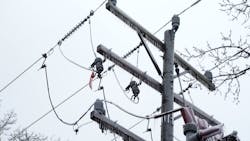A persistent blanket of fog, low clouds, and patchy drizzle insulated much of Dominion Energy Virginia’s service territory during and after a severe winter storm, which caused power outages and destruction from coast to coast. In Virginia, temperatures hovered around 30° while freezing rain produced widespread ice accumulation.
"This was the most destructive ice storm in two decades," says Alan Bradshaw, director of electric distribution operations for Dominion Energy Virginia. "It brought significant damage to parts of central and southern Virginia over the weekend, and power was disrupted to nearly 300,000 customers in the storm."
Ice Issues
Major ice storms have the potential to cause more damage and more challenging working conditions than a hurricane, says Bradshaw, who estimated that ice accumulation ranged from .25 in. to .75 in. in some areas.
“A fast-moving hurricane rolls through and the damage is done; but when we have freezing rain for days, ice accumulation gradually builds up and outages continue to occur even as crews make repairs,” he says. “There’ll be times when our crews will be working but may have to step back due to unsafe working conditions. Crews must work cautiously to protect customers and themselves.”
Ice slows down the power restoration process because it causes extremely dangerous travel conditions and makes some areas nearly impossible to access. The weight of the ice also burdens trees and tree limbs and causes them to fall, creating outages and hazardous working conditions. As ice starts to melt, the trees snap back into place and can spark a second round of damage. This can result in repeating restoration efforts in those locations.
Dominion Energy had not experienced an ice storm of this magnitude in quite some time, and after enduring this event, it reinforced how well the utility’s model applies to all types of storm restoration.
“Our storm restoration model is flexible and scalable and allows our team to be at their best when our customers need us most – even in the most difficult conditions,” Bradshaw says. “We understand that no two storms are the same but believe that all will fit our model.”
Team Effort
More than 7,000 workers and more than 900 bucket trucks were dedicated to the restoration effort, including crews from neighboring utilities in 19 states, Washington D.C., and Canada.
“We restored power to 95% of our customers who were impacted in about 80 hours after peak impact,” Bradshaw says. “Crews worked day and night to make complex repairs, which included removing trees from lines, replacing broken poles and crossarms and repairing downed power lines.”
Dominion Energy’s team also had to prepare for a second round of ice and freezing rain on Thursday, February 18, as the utility was wrapping up restoration efforts from the first storm.
“We maintained our focus on restoring service to all customers and then being able to immediately transition to the preparation and restoration for the possibility of an even more damaging ice storm in Virginia,” Bradshaw says.
Spotlight on Safety
Following a storm, Bradshaw says the best practice is to be prepared, have a plan and focus on safety. At Dominion Energy Virginia, safety is a number one priority. For example, with the ice storm creating dangerous working conditions, crews had to find shelter during the event as trees were falling. Once it was deemed safe enough, crews were able to go back out and continue restoration efforts.
“All the line workers deserve a lot of credit for working in such challenging conditions, especially during the pandemic,” Bradshaw says. “Crews continued to practice social distancing and wear proper face coverings. They wore ice cleats to have better footing and dressed in layers and waterproof overcoats to help stay dry.”
As a result of COVID, the utility couldn’t set up traditional processing and staging centers. Dominion Energy adapted its approach by creating a drive-through staging center where crews could get equipment, food, and fuel without having to leave their vehicles.
Damage Assessment
At Dominion Energy Virginia, the patrol teams perform damage assessment using a mobile tool. By using this tool, they can pinpoint damages and take pictures, which are automatically uploaded into the utility’s outage management system. The results are then displayed in the system storm center on a variety of situational awareness dashboards.
“This quick access to damage assessment data provides evidence of the storm’s impact and informs both resource decisions and the ability to provide estimated restoration times to our customers,” Bradshaw says.
Dominion Energy typically uses drones and helicopters to assist with damage assessment, but with the low clouds and fog, it wasn’t ideal for this particular storm response.
Strengthening the Grid
To minimize storm-related damage to its system and improve reliability, Dominion Energy has invested in its Grid Transformation Plan. For example, the utility is rebuilding, relocating and undergrounding targeted main lines and implementing new design standards to improve electric distribution throughout the system. The company had also undergrounded some of the utility’s most outage-prone “tap lines,” which connect a main power line to an individual neighborhood.
In addition, new design standards include taller, stronger poles and shorter spans of wire between poles. This will allow the poles and lines to withstand more impact, making it more resilient against ice and wind. Finally, Dominion Energy has also invested significant resources in winterizing power stations and placing key equipment indoors.
“Events like this ice storm show the importance of a strong infrastructure,” Bradshaw says. “Our customers rely on us to provide safe, reliable energy. The effects of the ice storm could’ve been worse on our service territory, but the work we do every day to ensure reliability paid off.”
Amy Fischbach ([email protected]) is a Field Editor for the Electric Utility Operations section of Transmission & Distribution World magazine.
About the Author
Amy Fischbach
Electric Utilities Operations
Amy Fischbach is the Field Editor for T&D World magazine and manages the Electric Utility Operations section. She is the host of the Line Life Podcast, which celebrates the grit, courage and inspirational teamwork of the line trade. She also works on the annual Lineworker Supplement and the Vegetation Management Supplement as well as the Lineman Life and Lineman's Rodeo News enewsletters. Amy also covers events such as the Trees & Utilities conference and the International Lineman's Rodeo. She is the past president of the ASBPE Educational Foundation and ASBPE and earned her bachelor's and master's degrees in journalism from Kansas State University. She can be reached at [email protected].
